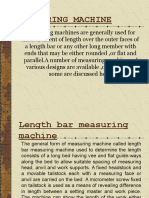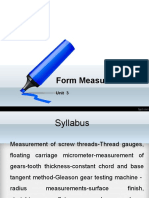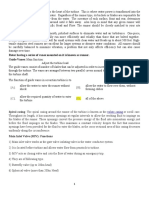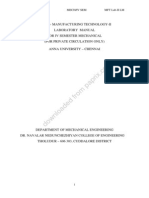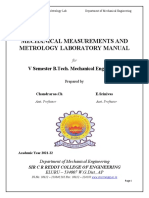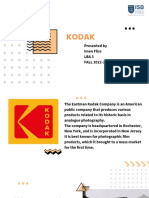0 ratings0% found this document useful (0 votes)
257 viewsMI Tool Makers Microscope
MI Tool Makers Microscope
Uploaded by
Gurpreet KaurA toolmaker's microscope is an optical measuring device that can measure parts up to 1/100th of a millimeter. Unlike a conventional light microscope, it is used as a measuring instrument to inspect and measure miniature mechanical and electronic components. It has a hollow base, circular stage, objective lens, eyepiece, and micrometer screws. Light illuminates the part and the objective lens projects the shadow onto a screen, allowing for precise linear, angular, and thread measurements of tools and small parts.
Copyright:
© All Rights Reserved
Available Formats
Download as PPTX, PDF, TXT or read online from Scribd
MI Tool Makers Microscope
MI Tool Makers Microscope
Uploaded by
Gurpreet Kaur0 ratings0% found this document useful (0 votes)
257 views9 pagesA toolmaker's microscope is an optical measuring device that can measure parts up to 1/100th of a millimeter. Unlike a conventional light microscope, it is used as a measuring instrument to inspect and measure miniature mechanical and electronic components. It has a hollow base, circular stage, objective lens, eyepiece, and micrometer screws. Light illuminates the part and the objective lens projects the shadow onto a screen, allowing for precise linear, angular, and thread measurements of tools and small parts.
Original Description:
All about tool maker's microscope.
Original Title
MI Tool makers microscope
Copyright
© © All Rights Reserved
Available Formats
PPTX, PDF, TXT or read online from Scribd
Share this document
Did you find this document useful?
Is this content inappropriate?
A toolmaker's microscope is an optical measuring device that can measure parts up to 1/100th of a millimeter. Unlike a conventional light microscope, it is used as a measuring instrument to inspect and measure miniature mechanical and electronic components. It has a hollow base, circular stage, objective lens, eyepiece, and micrometer screws. Light illuminates the part and the objective lens projects the shadow onto a screen, allowing for precise linear, angular, and thread measurements of tools and small parts.
Copyright:
© All Rights Reserved
Available Formats
Download as PPTX, PDF, TXT or read online from Scribd
Download as pptx, pdf, or txt
0 ratings0% found this document useful (0 votes)
257 views9 pagesMI Tool Makers Microscope
MI Tool Makers Microscope
Uploaded by
Gurpreet KaurA toolmaker's microscope is an optical measuring device that can measure parts up to 1/100th of a millimeter. Unlike a conventional light microscope, it is used as a measuring instrument to inspect and measure miniature mechanical and electronic components. It has a hollow base, circular stage, objective lens, eyepiece, and micrometer screws. Light illuminates the part and the objective lens projects the shadow onto a screen, allowing for precise linear, angular, and thread measurements of tools and small parts.
Copyright:
© All Rights Reserved
Available Formats
Download as PPTX, PDF, TXT or read online from Scribd
Download as pptx, pdf, or txt
You are on page 1of 9
Metrology and Instrumentation
Tool Maker’s Microscope
Submitted To:- Submitted By:-
Dr. Narinder Singh Gurpreet kaur
(School of Engg. and B.Tech(ME), 5th sem
Tech.) UG1833027001
TOOL MAKER’S MICROSCOPE
Unlike a conventional light microscope, a
toolmakers microscope is typically used as a
measuring device. As such, it can be used to
measure up to 1/100th of a mm. This makes
these microscopes suitable for such functions
as the inspection and measurement of various
miniature mechanical and electronic parts.
For instance, a toolmakers microscope can be
used for the purposes of viewing and
measuring thread pitch and thread angles
among others.
General Introduction
The toolmaker's microscope is an optical measuring machine
equipped for external & internal length measurements as well
as measurements on screw threads, profiles, curvatures &
angles.
A toolmakers microscope is a measuring device that can be
used to measure up to 1/100th of an mm.
It works on the principle of a screw gauge, but a few changes
were added to it to make its operation more easier.
It needs application of optics too.
A light focuses on the object & through lens we can see the
shadow of the object, which resembles the object.
More clear shadow would be enhance the accuracy of
measurement.
PARTS OF A TOOL MAKER’S MICROSCOPE
• A hollow base, which
accommodates the illumination
unit underneath.
• A circular stage surface (upper part
of the base) - It is made of
transparent glass and can be
rotated 360 degree.
• An objective lens.
• Eyepiece
• Two micrometer screws (One for
longitudinal movement and the
other for lateral movement of the
stage surface/table)
• Ground glass screen
WORKING OF THE TOOL MAKER’S MICROSCOPE
• The component being measured is
illuminated by the through light method.
• A parallel beam of light illuminates the
lower side of work-piece which is then
received by the objective lens in its way to
a prism that deflects the light rays in the
direction of the measuring ocular & the
projection screen.
• The direction of illumination can be tilted
with respect to the work-piece by tilting
the measuring head & the whole optical
system.
• This inclined illumination is necessary in
some cases as in screw thread
measurements.
USES
A toolmakers microscope has a robust base that allows it to hold a wide
range of objects for observations and measurements.
As multi functional devices, toolmaker tools will often be found in most
of the manufacturing companies/factories involved in the manufacturing
of machines, electronics and tools. In such places, they help in the
measurement of shapes, sizes, angles and positions of small components
which fall under the measuring range of the microscope. This makes the
microscope particular suitable for such tasks as measuring the shapes of
such components as milling cutters, thread gauge and guide screw among
others.
In addition, the device finds use for measuring center to center distance
of holes in a plane, linear measurements as well as accurate angular
measurements.
APPLICATIONS
Length measurement in Cartesian & polar co-ordinates.
Angle measurements of tools.
Thread measurements i.e., profile major & minor
diameters, height of lead, thread
angle, profile position with respect to the thread axis & the
shape of thread.
Comparison between centers & drawn patterns & drawing
of projected profiles.
Used for measuring the shape of different components like
the template, formed cutter, milling cutter, punching die,
and cam
BENEFITS
The toolmakers microscope is an important device given that it allows for
manufacturers and other technicians to observe and measure the small parts of various
tools and electronics among others. It has a number of advantages that makes it suitable
for such tasks. These include:-
• As compared to the optical comparators, a tool maker’s microscope is preferred when
the z-axis height information is required.
• The stage can be equipped with linear scales.
• They can easily adapt to both cameras CCTV's for photo documentation
requirements.
• The toolmakers microscope offers a variety of optical techniques Moreover, it can
use optics, which offer higher magnification resolution for better measuring
accuracy.
• It is ideal for measurements of hardness test indentations.
• Can be adopted for a variety of applications.
• It provides for precise measurements.
You might also like
- Zeiss Cirrus Photo 600 ManualDocument106 pagesZeiss Cirrus Photo 600 ManualDylan MyersNo ratings yet
- Appointment ConfirmationDocument3 pagesAppointment ConfirmationDpNo ratings yet
- Tool Makers MicroscopeDocument11 pagesTool Makers Microscopeirfanajai100% (1)
- Measuring MachineDocument19 pagesMeasuring Machinegopir28No ratings yet
- Unit 2 Shaper Planer SlotterDocument25 pagesUnit 2 Shaper Planer SlotterKrishnan VelavanNo ratings yet
- Mechanical Measurements and Metrology: Subject Code: 10ME32B Prepared By: Nikita Department: Aeronautical EngineeringDocument24 pagesMechanical Measurements and Metrology: Subject Code: 10ME32B Prepared By: Nikita Department: Aeronautical EngineeringvishnusankarNo ratings yet
- Lathe MachineDocument8 pagesLathe MachineVipin TitariyaNo ratings yet
- Hand Tools - Metal: Marking Out, Measurement, Fitting & AssemblyDocument16 pagesHand Tools - Metal: Marking Out, Measurement, Fitting & Assemblytarmizy100% (2)
- Unit-4 MMDocument74 pagesUnit-4 MMRama SamyNo ratings yet
- Form Measurement: Unit 3Document68 pagesForm Measurement: Unit 3Rama SamyNo ratings yet
- 2b. Fitting Trade 27112020Document29 pages2b. Fitting Trade 27112020Jeevan MandalaNo ratings yet
- Experiment-1: Study of Bench Grinding and It's OperationsDocument10 pagesExperiment-1: Study of Bench Grinding and It's OperationsMohammed RakibNo ratings yet
- Lab Viva Questions and Answers: 15ME46P Practice Core (Practice)Document7 pagesLab Viva Questions and Answers: 15ME46P Practice Core (Practice)jambuNo ratings yet
- Cam Vice ReportDocument52 pagesCam Vice ReportAnonymous rvhOrVmmbNo ratings yet
- Angle Measuring DevicesDocument17 pagesAngle Measuring DevicesIqbal Singh ParmarNo ratings yet
- Lathe AttachmentsDocument8 pagesLathe AttachmentsSuhas100% (1)
- Exp No 9 ShaperDocument5 pagesExp No 9 ShaperM IRFANNo ratings yet
- Name of The Experiment:: Study and Operation Bench Drilling MachineDocument5 pagesName of The Experiment:: Study and Operation Bench Drilling MachinemadNo ratings yet
- Recirculating Ball-ScrewDocument4 pagesRecirculating Ball-ScrewManish Dhar100% (1)
- Thread Cutting and Knurling To Make Nut and BoltDocument3 pagesThread Cutting and Knurling To Make Nut and BoltHassan AliNo ratings yet
- NEA PrepationDocument21 pagesNEA Prepationaziz100% (1)
- Surface PlateDocument5 pagesSurface Platetevqwe1No ratings yet
- Manufacturing Processes Sessional: Lab ReportDocument6 pagesManufacturing Processes Sessional: Lab ReportFarzana IslamNo ratings yet
- Grinding Machine Definition Parts Working Principle Operation Advantages Application Notes PDFDocument9 pagesGrinding Machine Definition Parts Working Principle Operation Advantages Application Notes PDFlawanyahaya21No ratings yet
- Drilling Machine: Definition, Parts, Operation, Types, Advantages, Application (Notes & PDF)Document18 pagesDrilling Machine: Definition, Parts, Operation, Types, Advantages, Application (Notes & PDF)Arvind DeokarNo ratings yet
- Introduction of Lathe Machine (Machine Shop)Document25 pagesIntroduction of Lathe Machine (Machine Shop)Muhammad AbubakarNo ratings yet
- Source of HeatDocument9 pagesSource of HeatSreekumar RajendrababuNo ratings yet
- Lathe PDNDocument108 pagesLathe PDNSagar Shinde100% (1)
- Experiment No.: Experiment Name:: TypesDocument4 pagesExperiment No.: Experiment Name:: TypesMirMdMarufHossainNo ratings yet
- BME Unit IV Machine ToolsDocument41 pagesBME Unit IV Machine ToolsArvind BhosaleNo ratings yet
- Me 8513 MM Lab 2022 OddDocument63 pagesMe 8513 MM Lab 2022 OddVelan PrintersNo ratings yet
- Experiment No. 1: AIM: To Study Single Point Cutting ToolDocument40 pagesExperiment No. 1: AIM: To Study Single Point Cutting ToolShreyas GajapureNo ratings yet
- Mec 126 Lecture NoteDocument11 pagesMec 126 Lecture Notemboniface763No ratings yet
- Machine Alignment TestDocument4 pagesMachine Alignment TestSudhanwa KulkarniNo ratings yet
- Milling MachineDocument7 pagesMilling MachineNishit ParmarNo ratings yet
- Upright Drilling MachineDocument3 pagesUpright Drilling Machinevenkateshyadav2116100% (2)
- MFT2 Lab 2Document48 pagesMFT2 Lab 2dellibabu509No ratings yet
- MM&M LAB STUDENT MANUAL Front PagesDocument6 pagesMM&M LAB STUDENT MANUAL Front Pageschandrarao chNo ratings yet
- Machine Tools LabDocument85 pagesMachine Tools Labmohammad sammeerNo ratings yet
- Geometry of Twist DrillDocument15 pagesGeometry of Twist Drillbest4reverNo ratings yet
- Screw Thread N GearsDocument71 pagesScrew Thread N Gearshyundai310100% (3)
- Metrology-Lab-Manual 3 Year 1semDocument41 pagesMetrology-Lab-Manual 3 Year 1semBHARATH Chandra100% (1)
- MFT 2 Lab Manual-SasiDocument46 pagesMFT 2 Lab Manual-Sasisikkandar faizNo ratings yet
- Murali - Metrology & Measurements Lab ManualDocument30 pagesMurali - Metrology & Measurements Lab ManualsubhashNo ratings yet
- 65e0233c88677 Submission Template Varroc Eureka Challenge 2.0 NewDocument15 pages65e0233c88677 Submission Template Varroc Eureka Challenge 2.0 Newmr.tommy12143No ratings yet
- Main Parts of Capstan Lathe and Turret LatheDocument8 pagesMain Parts of Capstan Lathe and Turret LatheShuvoVatt0% (1)
- Name Harshal Bhatt Department Mechanical 2 YearDocument30 pagesName Harshal Bhatt Department Mechanical 2 YearRahul KhatriNo ratings yet
- Wire Rope Excavator/cranesDocument20 pagesWire Rope Excavator/cranesBhanu ChanderNo ratings yet
- Capstan & Turret LatheDocument27 pagesCapstan & Turret LatheMuraliNo ratings yet
- Angular Indexing Part and FunctionsDocument18 pagesAngular Indexing Part and FunctionsArielle Joyce de JesusNo ratings yet
- Shaper and PlannerDocument33 pagesShaper and PlannerCody Lee100% (1)
- Unit 1 Power Transmission DevicesDocument69 pagesUnit 1 Power Transmission DevicesAbhijeet somawarNo ratings yet
- DustpanDocument12 pagesDustpanSachin KhadkaNo ratings yet
- RAC - Unit 5 - Working of Window ACDocument11 pagesRAC - Unit 5 - Working of Window ACSAATVIK JAINNo ratings yet
- Experimental Measurement of Boiling Point ElevationDocument33 pagesExperimental Measurement of Boiling Point Elevationsuleman205100% (3)
- MCMT Unit-IIDocument190 pagesMCMT Unit-IISai RamNo ratings yet
- Metrology and Measurements Unit 3 Form MeasurementDocument79 pagesMetrology and Measurements Unit 3 Form MeasurementgurunathramNo ratings yet
- Experiment No. 1: Study of Universal 3 Jaw Chuck Lathe MachineDocument5 pagesExperiment No. 1: Study of Universal 3 Jaw Chuck Lathe MachineHasnain AshrafNo ratings yet
- Screwthread and Gear MeasurementDocument19 pagesScrewthread and Gear MeasurementseenuNo ratings yet
- Gear Cutting NotesDocument28 pagesGear Cutting NotesNEERAJ KISHORE PNo ratings yet
- The ToolmakeeerDocument31 pagesThe ToolmakeeerVarunNo ratings yet
- The Tool MakerDocument4 pagesThe Tool MakerRitesh YadavNo ratings yet
- Penawaran Harga Pembuatan Video Profil Dinas Pertanahan Provinsi Sulawesi TengahDocument5 pagesPenawaran Harga Pembuatan Video Profil Dinas Pertanahan Provinsi Sulawesi TengahJulian CesarNo ratings yet
- Kodak Case StudyDocument16 pagesKodak Case StudyImeen flissNo ratings yet
- Forsem QuestionsDocument8 pagesForsem Questionsreynaldocanlas714No ratings yet
- 02 Assignment (2) - Photogrammetry-Planning Areal PhotographyDocument1 page02 Assignment (2) - Photogrammetry-Planning Areal PhotographyMohammed NabilNo ratings yet
- Service Manual MP-150Document16 pagesService Manual MP-150Silverio SogorbNo ratings yet
- 66 Distance System, Cruise Control, Remote OperationDocument33 pages66 Distance System, Cruise Control, Remote OperationaterrohotmailNo ratings yet
- Matrice30 Series User Manual v2.0 enDocument138 pagesMatrice30 Series User Manual v2.0 enjuk expertNo ratings yet
- Coal Silo Fire ProtectionDocument20 pagesCoal Silo Fire ProtectionKrishna N HNo ratings yet
- Tencor P-7Document8 pagesTencor P-7RendraNo ratings yet
- RS232 Camera User Guide V1.1Document15 pagesRS232 Camera User Guide V1.1pepitoNo ratings yet
- Xiaomi Redmi 10 - Full Phone SpecificationsDocument2 pagesXiaomi Redmi 10 - Full Phone Specificationsrofiulum15No ratings yet
- Economy Pressure Calibrator: NagmanDocument2 pagesEconomy Pressure Calibrator: NagmantruongNo ratings yet
- Quote For Cognex IS2800 - Purshotam - 266Document2 pagesQuote For Cognex IS2800 - Purshotam - 266jameschandruuNo ratings yet
- Film Analysis (Discussion)Document69 pagesFilm Analysis (Discussion)Angelgrace TiempoNo ratings yet
- Canon Eos Rebel t7 Specifications ChartDocument10 pagesCanon Eos Rebel t7 Specifications ChartCarlos OrdóñezNo ratings yet
- Training - Dimensional NotesDocument17 pagesTraining - Dimensional Noteshuyenhvtc252No ratings yet
- Aesculap PV440 Camera System - User ManualDocument192 pagesAesculap PV440 Camera System - User Manualprzy3_14No ratings yet
- I Hib5pi VSDocument3 pagesI Hib5pi VSdhavalheaven2023No ratings yet
- Inverted Research Microscope ECLIPSE TiDocument15 pagesInverted Research Microscope ECLIPSE TiCuma MencobaNo ratings yet
- BIO210 Lab Report 2Document6 pagesBIO210 Lab Report 2Isra MallaNo ratings yet
- IPC-TM-650 Test Methods ManualDocument1 pageIPC-TM-650 Test Methods ManualWim Op 't VeldNo ratings yet
- Acta Ophthalmologica - 2020 - Ota - Subjective and Objective Refractions in Eyes With Extended Depth of Focus IntraocularDocument7 pagesActa Ophthalmologica - 2020 - Ota - Subjective and Objective Refractions in Eyes With Extended Depth of Focus IntraocularFachry RahmanNo ratings yet
- Camera Notes For PhotogrammetryDocument61 pagesCamera Notes For PhotogrammetryAnuran GayaliNo ratings yet
- King Abdullah Road - West Section Part A Bill No. Description Amount (S.R) General Summary of Part ADocument17 pagesKing Abdullah Road - West Section Part A Bill No. Description Amount (S.R) General Summary of Part AenesNo ratings yet
- FRDPARRC Rotary WingDocument3 pagesFRDPARRC Rotary WinghuyhuyhuydxdNo ratings yet
- Photography ClubDocument4 pagesPhotography ClubPhúc NguyễnNo ratings yet
- Chatgpt Learn MidDocument5 pagesChatgpt Learn MidN. AL-HassanNo ratings yet
- Manual KeyenceDocument150 pagesManual KeyenceBeatriz Vera BetancourtNo ratings yet



